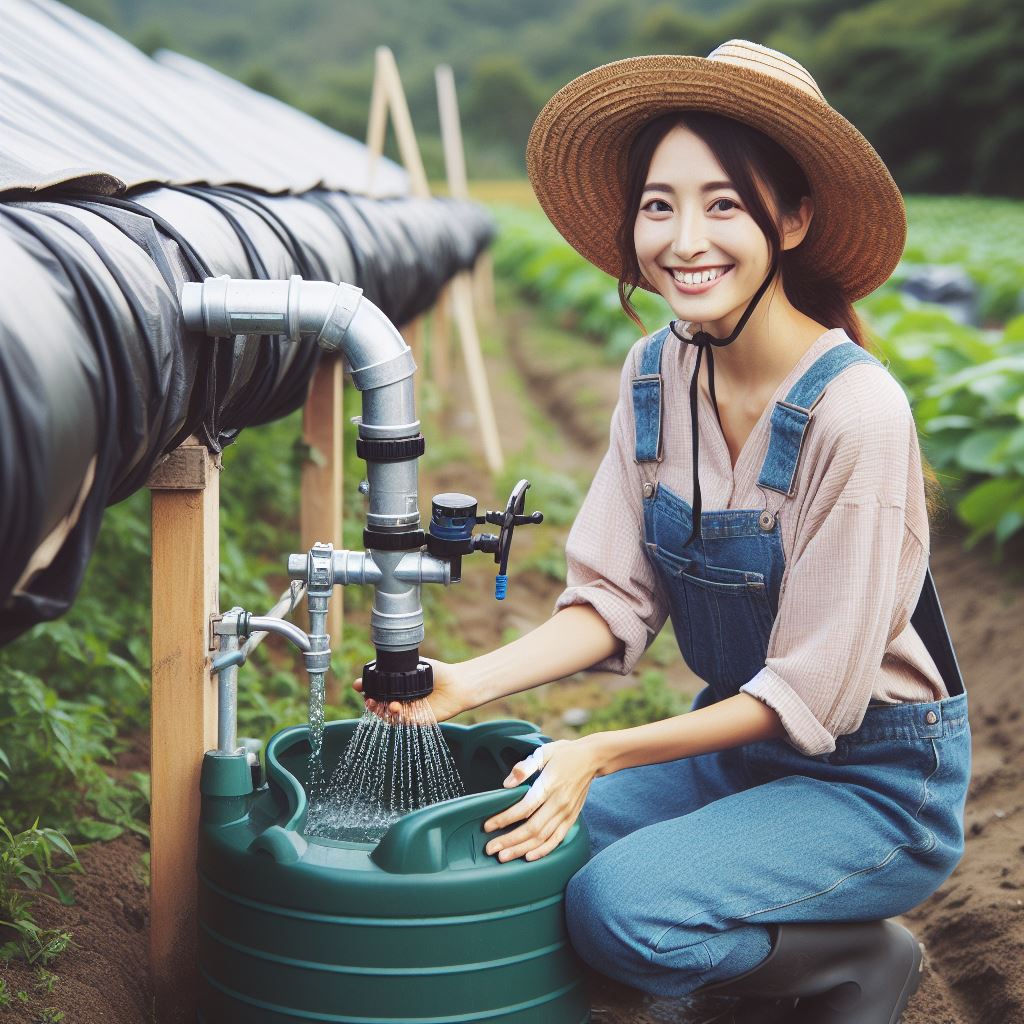Introduction
In today’s world, agriculture encounters a pressing issue: water scarcity.
However, amidst this challenge, there’s a beacon of hope in the form of innovative techniques designed to conserve water in farming practices.
The significance of this cannot be overstated, as water is not only a precious resource but also a fundamental element for agricultural productivity and environmental health.
Water conservation in agriculture is crucial for several reasons.
Firstly, it ensures the sustainability of agricultural practices by preserving water resources for future generations.
Additionally, it helps to mitigate the impact of droughts and other water-related challenges, which are becoming increasingly prevalent due to climate change.
Moreover, efficient water use in farming can lead to higher crop yields, improved soil health, and reduced environmental degradation.
The purpose of this blog post is to explore the latest advancements in water-saving innovations within the realm of farming.
We will delve into various cutting-edge methods and technologies that farmers around the world are adopting to optimize water usage while maintaining or even enhancing crop productivity.
By understanding these innovative approaches, we can gain insights into how sustainable agriculture can be achieved in the face of water scarcity.
Throughout this blog, we will discuss the principles behind water-saving techniques, their practical applications, and the potential benefits they offer to farmers, ecosystems, and society as a whole.
Join us on this journey as we uncover the future of water-efficient farming practices.
Water-efficient irrigation systems
Water-saving innovations in farming have become increasingly important, considering the ever-growing demand for food production and the limited availability of freshwater resources.
To address this issue, advancements in irrigation technology have played a vital role in conserving water and improving agricultural practices.
One of the most significant developments in water-efficient irrigation is the drip irrigation system.
This irrigation method works by delivering water directly to the roots of plants, minimizing wastage significantly.
Through a network of tubes or pipes, small amounts of water are slowly and accurately dripped onto the soil near each plant.
This ensures that plants receive the necessary moisture without excess water evaporating or being lost to surface runoff.
Advancements in irrigation technology
The benefits and effectiveness of drip irrigation are numerous.
Firstly, it reduces water wastage by nearly 50%, compared to traditional irrigation methods.
This water-saving technology is especially beneficial in areas with limited water availability or in regions prone to drought.
Additionally, drip irrigation improves nutrient absorption by supplying water directly to the root zone, enhancing plant growth and reducing the need for fertilizers.
Sprinkler irrigation system
Another popular water-efficient irrigation system is the sprinkler irrigation system.
This method involves spraying water over the fields, simulating rainfall.
There are different types of sprinkler systems available, including overhead, center pivot, and traveling sprinklers.
Each type has its advantages, such as flexible coverage options, fast application rates, and reduced labor requirements.
Sprinkler irrigation ensures uniform water distribution, making it suitable for various crop types and terrains.
The versatility of this system allows farmers to adjust the sprinkler heads’ position and trajectory to meet specific crop water requirements.
Furthermore, the reduced labor requirements associated with sprinkler irrigation enable farmers to allocate their resources more efficiently.
Precision irrigation system
Precision irrigation is another cutting-edge technology that has revolutionized water-saving practices in farming.
This method involves measuring and controlling the water supply to ensure that plants receive the correct amount of water at the right time.
By using sensors, data analysis, and smart irrigation systems, precision irrigation optimizes water usage and reduces waste.
The concept behind precision irrigation is to provide plants with water based on their actual needs.
By monitoring factors such as soil moisture levels, weather conditions, and plant growth stages, farmers can efficiently allocate water resources.
This approach leads to increased crop yield, improved quality, and minimized environmental impacts.
In fact, water-efficient irrigation systems have emerged as essential tools in modern farming.
Advancements like drip irrigation, sprinkler irrigation, and precision irrigation have transformed the way water is used in agriculture.
By minimizing water wastage, improving nutrient absorption, and optimizing irrigation practices, these innovations contribute to sustainable farming practices and help secure future food production in a water-scarce world.
Crop selection and rotation
Importance of selecting drought-tolerant crops
By carefully selecting drought-tolerant crops, farmers can significantly reduce water consumption while maintaining agricultural productivity.
These crops have evolved to survive in arid conditions and possess efficient water-use strategies.
Their ability to tolerate water scarcity, coupled with reduced irrigation requirements, makes them an ideal choice for water-saving farming practices.
In addition to selecting the right crops, implementing crop rotation further enhances water usage efficiency.
Crop rotation involves alternating the types of crops grown in a particular area over different seasons.
This practice helps break the continuous cultivation of water-demanding crops, mitigating the need for excessive irrigation.
By diversifying crop selection, farmers can balance water consumption and reduce the strain on limited water resources.
Benefits of crop rotation in terms of water usage
Crop rotation not only reduces water usage but also provides several additional benefits.
It minimizes soil erosion by maintaining soil structure and organic matter content, allowing the soil to retain water better.
The practice also promotes the natural replenishment of nutrients, reducing the reliance on synthetic fertilizers.
Moreover, crop rotation helps control pests and diseases as different crops attract varying pests, limiting their buildup.
Transform Your Agribusiness
Unlock your farm's potential with expert advice tailored to your needs. Get actionable steps that drive real results.
Get StartedExamples of crops suitable for water conservation
There are various crops suitable for water conservation that farmers can consider incorporating into their rotation plans.
Succulent plants, such as aloe vera and cacti, have adapted to arid environments and possess water-storing capabilities, requiring minimal irrigation.
Millets, like pearl millet and finger millet, are traditional crops known for their resilience to dry conditions and minimal water needs.
Legumes, such as lentils and chickpeas, not only have lower water requirements but also contribute nitrogen to the soil through their symbiotic relationship with nitrogen-fixing bacteria.
Sweet potatoes are highly efficient in water usage and are well-suited for regions with limited water availability.
Additionally, exploring indigenous crop varieties can reveal hidden gems that are naturally adapted to local climatic conditions, thus reducing the need for excessive watering.
In short, crop selection and rotation play a crucial role in water-saving innovations in farming.
By opting for drought-tolerant crops and implementing crop rotation techniques, farmers can optimize water usage and contribute to water conservation efforts.
The examples provided offer a starting point for farmers looking to embrace water-saving practices while maintaining agricultural productivity.
Rainwater Harvesting
Process of Rainwater Harvesting
Rainwater harvesting is the collection and storage of rainwater for various uses.
The process involves the following steps:
- Rainwater is collected from rooftops or other surfaces.
- The collected water is filtered to remove debris and impurities.
- The filtered water is then stored in tanks or reservoirs for future use.
- The stored water can be used for irrigation, livestock, or even drinking purposes.
Methods and Techniques Used in Agricultural Rainwater Harvesting
There are several methods and techniques used in agricultural rainwater harvesting:
- Contour farming involves creating ridges and furrows along the natural contours of the land to capture rainwater.
- Terracing is a technique where steps are built into sloping land to prevent runoff and allow water to infiltrate the soil.
- Water catchment systems are structures designed to collect and store rainwater from large catchment areas.
Advantages and Potential Challenges of Rainwater Harvesting
Rainwater harvesting offers several advantages for farming:
- It reduces dependency on traditional water sources like rivers and groundwater.
- It helps in replenishing the water table and conserves natural resources.
- It provides a reliable and sustainable source of water for irrigation purposes.
- It reduces soil erosion and improves soil moisture content, leading to better crop growth.
However, there are some potential challenges to consider:
- Initial setup costs for rainwater harvesting systems can be high.
- Ensuring proper maintenance and regular cleaning of storage tanks is crucial.
- In areas with limited rainfall, the collected water may not be sufficient during dry periods.
- Education and awareness campaigns are needed to promote rainwater harvesting among farmers.
Despite these challenges, rainwater harvesting holds great potential for sustainable farming practices.
By effectively harnessing rainwater, farmers can enhance their agricultural productivity while conserving water resources.
Read: Eco-Farming: Beating Climate Change
Soil management and conservation practices
In agriculture, proper soil management and conservation practices play a vital role in water-saving innovations.
Here, we will discuss the significance of healthy soil for water conservation and the benefits of sustainable soil management practices.
The significance of healthy soil for water conservation
Soil health is essential for successful water-saving innovations in farming.
By focusing on soil management and conservation, farmers can optimize water use, improve crop yields, and protect the environment.
Organic matter and soil structure are key elements.
Organic matter improves soil structure, allowing for better water infiltration and reducing runoff.
On the other hand, cover crops and mulching techniques further enhance water conservation efforts.
Cover crops like legumes reduce evaporation, protect soil from erosion, and keep the soil moist, decreasing the need for additional watering.
The benefits of sustainable soil management practices
Sustainable soil management practices offer several benefits for water-saving innovations.
By implementing conservation tillage techniques, such as reducing or eliminating plowing, farmers can minimize evaporation and runoff.
Additionally, crop rotation prevents the build-up of pests and diseases, improving overall plant health and reducing the need for excessive irrigation.
These practices ultimately conserve water resources and reduce the environmental impact of agriculture.
Another advantage of sustainable soil management is the increased water holding capacity of the soil.
By focusing on improving organic matter content and soil structure, farmers can enhance the soil’s ability to retain moisture.
This reduces the need for frequent irrigation, conserving water in water-scarce regions or during drought periods.
Moreover, by optimizing water use, farmers can improve crop yields and economic returns while reducing dependency on external water sources.
In general, healthy soil is crucial for water conservation in farming.
By prioritizing soil management and conservation practices that enhance organic matter, soil structure, and water holding capacity, farmers can contribute to water-saving innovations.
Sustainable techniques reduce evaporation, runoff, and external water requirements, leading to improved crop yields and environmental sustainability in agriculture.
Investing in soil health is a proactive approach that benefits both farmers and the planet.
Read: Biochar: Farming’s Climate Fix

Technology and digital solutions
Explore the use of technology in water-saving farming practices
One of the major technological advancements in water-saving farming practices is the use of sensors and data analytics.
By deploying sensors in the fields, farmers can gather real-time data on soil moisture levels.
This information enables them to determine the precise amount of water required by their crops.
By avoiding over-irrigation, farmers can prevent water wastage while ensuring optimal plant growth.
Another valuable technology is the automated irrigation system.
These systems utilize data from sensors and weather forecasts to automatically adjust the irrigation schedule and water application.
By considering factors such as evapotranspiration rates and rainfall, automated irrigation systems ensure that crops receive the right amount of water at the right time.
This technology maximizes water efficiency and reduces unnecessary water consumption.
The role of precision agriculture in optimizing water usage
Precision agriculture involves the use of advanced technologies, such as GPS, satellite imagery, and drones, to optimize various agricultural practices.
When it comes to water usage, precision agriculture plays a crucial role in minimizing wastage and maximizing efficiency.
Through the use of GPS and satellite imagery, farmers can accurately map their fields and identify areas with varying water requirements.
This allows them to implement site-specific irrigation, delivering water precisely where it is needed.
By avoiding blanket irrigation across the entire field, farmers can conserve water and reduce the risk of overwatering or underwatering certain areas.
Furthermore, drones equipped with thermal and multispectral cameras can provide detailed information about crop health and water stress levels.
By detecting areas of drought stress early on, farmers can take proactive measures to address the issue and ensure optimal water utilization.
In a nutshell, technology and digital solutions have significantly contributed to water-saving innovations in farming.
Sensors, data analytics, automated irrigation systems, and precision agriculture techniques have revolutionized the way water is used in agriculture.
By adopting these technologies, farmers can optimize water usage, conserve resources, and contribute to sustainable farming practices.
Read: Storms & Soil Erosion: Safeguarding US Farmlands
Showcase Your Farming Business
Publish your professional farming services profile on our blog for a one-time fee of $200 and reach a dedicated audience of farmers and agribusiness owners.
Publish Your ProfileGovernment and Financial Support
Government Initiatives and Policies
The government plays a crucial role in promoting water conservation in agriculture through various initiatives and policies.
These measures aim to address the pressing issue of water scarcity and ensure the sustainable use of water resources.
- Water Rights and Regulations: Governments establish water rights and regulations to manage water allocation effectively. These regulations ensure fair distribution and prevent overexploitation of water resources in agricultural practices.
- Water Pricing and Tariffs: Governments implement pricing mechanisms and tariffs to encourage efficient water use. Higher prices for excessive water consumption create an economic incentive for farmers to adopt water-saving innovations.
- Conservation Education Programs: Government-funded conservation education programs raise awareness among farmers about the importance of water-saving techniques. These programs provide training and awareness sessions to help farmers understand the benefits and methods of conservation.
- Research and Development Funding: Governments allocate funds to support research and development of water-saving technologies in agriculture. These investments enable scientists and innovators to develop advanced irrigation systems and crop management techniques that optimize water usage.
Financial Assistance and Incentives
Financial assistance and incentives are crucial in encouraging farmers to implement water-saving innovations.
Various programs and schemes are available to provide support and financial aid to farmers in adopting sustainable farming practices.
- Grants and Subsidies: Governments offer grants and subsidies to farmers who invest in water-saving technologies and equipment. These financial aids help reduce the initial investment costs associated with the adoption of innovative irrigation systems.
- Tax Credits and Deductions: Tax incentives such as credits and deductions are provided to farmers implementing water-saving practices. This reduces the overall tax burden, making it easier for farmers to adopt and maintain water-efficient farming methods.
- Low-Interest Loans: Financial institutions, with the support of the government, offer low-interest loans specifically designed for farmers investing in water-saving innovations. These loans provide farmers with the necessary capital to implement water-efficient technologies.
- Insurance Premium Discounts: Insurance companies offer premium discounts to farmers who utilize water-saving innovations. This incentive acts as a reward for proactive water conservation practices and helps mitigate financial risks associated with crop failure or water scarcity.
- Collaboration with NGOs and Private Sectors: Governments collaborate with non-governmental organizations (NGOs) and private sectors to establish funding partnerships. These collaborations help provide additional financial support to farmers, creating a more widespread adoption of water-saving innovations.
Basically, government initiatives and financial support play a crucial role in promoting water-saving innovations in farming.
Through water rights, regulations, conservation education programs, and research funding, governments encourage sustainable water use.
Financial assistance in the form of grants, subsidies, loans, and insurance discounts further incentivize farmers to adopt water-saving technologies.
By combining these efforts, governments can ensure the long-term viability and sustainability of agriculture while conserving precious water resources.
Read: Urban Farms: Answer to Climate?
Success stories and case studies
Real-life examples of farmers successfully implementing water-saving innovations
- Debbie Johnson, a farmer from California, implemented drip irrigation and reduced her water usage by 50%.
- Juan Gomez, a farmer in Mexico, adopted precision farming techniques, resulting in a 30% reduction in water consumption.
- Sarah Brown, an organic farmer in Australia, implemented rainwater harvesting systems, leading to a 60% decrease in her reliance on irrigation.
- Rajesh Singh, a farmer in India, switched to hydroponics and managed to save up to 70% of water compared to traditional farming methods.
- Mark Thompson, a farmer in Nebraska, implemented soil moisture sensors, resulting in a 40% reduction in overall water usage.
Impact and outcomes of their efforts
- Debbie Johnson’s implementation of drip irrigation not only saved water but also increased her crop yield by 20%.
- Juan Gomez’s adoption of precision farming techniques not only reduced water consumption but also improved overall crop health and quality.
- Sarah Brown’s rainwater harvesting systems not only decreased her reliance on irrigation but also helped replenish local groundwater resources.
- Rajesh Singh’s switch to hydroponics not only saved water but also increased his farm’s productivity and profitability.
- Mark Thompson’s use of soil moisture sensors not only reduced water usage but also prevented overwatering, leading to healthier plants and reduced disease risk.
Inspiring readers to adopt similar practices
- These success stories highlight the tangible benefits of implementing water-saving innovations in farming.
- By adopting these practices, farmers can reduce their environmental impact while ensuring sustainable agriculture.
- Water scarcity is a global issue, and these farmers serve as inspiring examples of how individuals can make a difference.
- Implementing water-saving innovations not only conserves valuable resources but can also lead to increased profits for farmers.
- It is crucial for farmers, policymakers, and consumers to support and promote these water-saving practices to secure a sustainable future.
By sharing real-life examples and their positive outcomes, we hope to inspire readers and encourage them to adopt similar water-saving practices in their own farming endeavors.
These success stories demonstrate that it is possible to mitigate water scarcity challenges and achieve sustainability in agriculture.
Together, we can make a significant impact on the environment and ensure a brighter future for generations to come.
Explore Further: Crop Diversification in Changing Climate
Conclusion
Throughout this exploration, we’ve delved into an array of ingenious water-saving innovations tailored for farming.
These advancements encompass a spectrum of techniques, from the precision of drip irrigation to the intricacies of soil moisture sensors.
The importance of these innovations cannot be overstated. In the realm of agriculture, where water is both a precious resource and a limiting factor, adopting such technologies is paramount.
They offer a lifeline to farmers striving to navigate the complexities of water scarcity while sustaining their livelihoods.
It is incumbent upon us, as stewards of the land and architects of our agricultural future, to wholeheartedly embrace these practices.
By implementing water-saving innovations, we not only ensure the resilience of our farms but also contribute to the broader mission of environmental sustainability.
Each drop saved, each crop nurtured more efficiently, serves as a testament to our commitment to a greener, more sustainable tomorrow.




